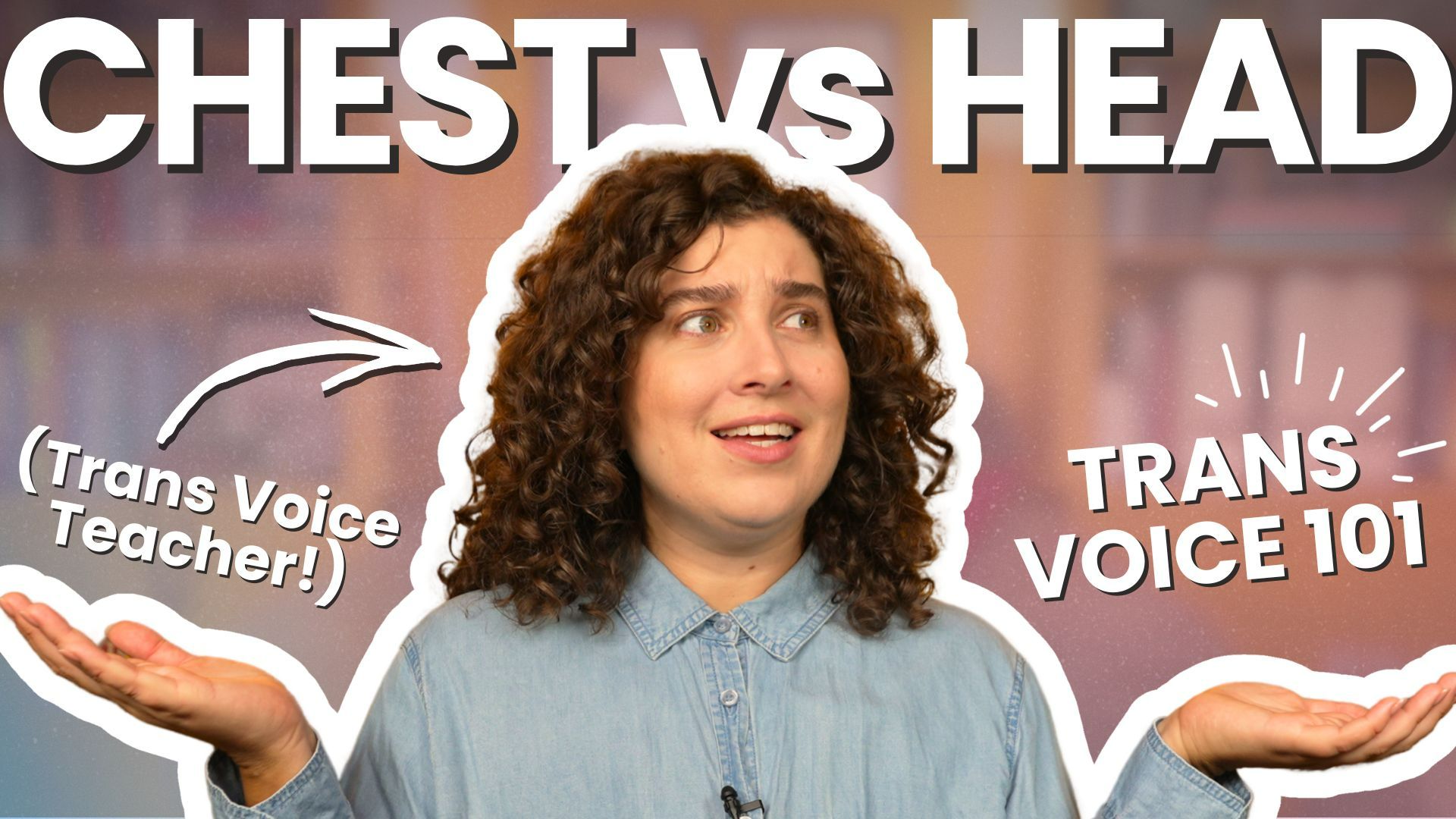"I Can't Voice Train!" Try This One Exercise (It Actually Works)
Oct 02, 2025
If you've ever thought, "I just can't do trans voice training," you're not alone. Many people feel stuck when they first start working on their voice. However, there's one simple exercise that consistently disproves this limiting belief: the Key-Oh Exercise.
As a gender-affirming voice teacher, I've seen this exercise work for countless students who were convinced nothing would help them. It's simple, powerful, and shows you that your voice can shift in ways you might not expect. Best of all? You'll probably hear results immediately.
What Is the Key-Oh Exercise?
The Key-Oh Exercise is a fundamental voice training technique that works by modifying your vocal resonance. While resonance is a complex topic (which I cover extensively in my other resources), this exercise cuts straight to practical results without requiring deep technical knowledge.
The beauty of this exercise lies in its simplicity, combined with its effectiveness. Many students have told me that when they were convinced nothing worked, the Key-Oh Exercise showed them they were wrong.
Watch the Full Tutorial
Prefer to read? Keep scrolling for the complete written guide, including common pitfalls and troubleshooting tips.
How to Do the Key-Oh Exercise
The Key-Oh Exercise uses your natural ability to modify vowels to create vocal changes. The technique is slightly different depending on your goals:
For Voice Masculinization (Creating a Darker, Deeper Sound)
- Start with "oh": Say a big, relaxed "oh" sound. Notice how it feels—open, spacious, relaxed.
- Memorize that feeling: Pay attention to the vocal space and resonance of that "oh"
- Hold onto it for "key": Now say "key" while maintaining that same big, open feeling from "oh"
- Practice the sequence: "Oh... oh... key... key"
The goal is to bring the darker, bigger resonance of "oh" into your "key" sound.
For Voice Feminization (Creating a Lighter, Brighter Sound)
- Start with "key": Say a small, cute "key" sound. Notice the shape—bright, forward, compact.
- Memorize that shape: Pay attention to where you feel the resonance and how your mouth is positioned
- Use it for "oh": Now say "oh" while maintaining that same small, bright quality from "key"
- Practice the sequence: "Key... key... oh... oh"
The goal is to bring the lighter, brighter resonance of "key" into your "oh" sound.
Practice Guidelines
Practice this exercise for just a few minutes each day. The key is consistency and awareness—really paying attention to the feelings and sounds you're creating. As you become more comfortable with this exercise, you'll build on it to create more lasting changes in your everyday voice.
Common Pitfalls and How to Fix Them
Even simple exercises can go wrong if you're not aware of common mistakes. Here are ten pitfalls to avoid, along with quick fixes:
1. Going Too Fast
The Problem: Rushing through the exercise doesn't give you enough time to observe, analyze, and adjust what's happening with your voice.
The Fix: Slow down. Pause after each attempt to notice what changed and make adjustments.
2. Too Much Facial Tension
The Problem: A frozen face or over-tightened muscles can make this exercise sound unnatural and tense.
The Fix: Relax your face. Shake out tension, do "blah blah blah" exercises, make fish faces, or stretch your tongue before trying again.
3. Losing Vowel Definition
The Problem: Too much tension can result in vowels that don't sound quite right (saying "key, eh" or "key, uh" instead of "key, oh").
The Fix: Keep your lips and tongue mobile and make sure you're still shaping a clear "oh" sound.
4. List Prosody
The Problem: When we treat "key" and "oh" like items on a list (think: "eggs, bananas, and milk"), it naturally has a descending shape. This can work against your goals, especially if you're aiming for a lighter, brighter sound.
The Fix: Treat "key" and "oh" as equals with the same energy, not like items on a list.
5. Falling Pitch or Energy at the End of Words
The Problem: Many words naturally fall at the end (like words ending in "-ing": shopping, walking, talking). This natural fall causes you to lose all the energy you're using to create your desired voice quality.
The Fix: Consciously maintain energy and airflow. Carry support through to the very end of each word.
6. Turning It Into a Question
The Problem: If you're working on creating a darker, bigger sound, rising into a question pattern will cause you to lose the vocal space that creates that dark resonance.
The Fix: Say it as a statement and avoid rising inflection.
7. Leaving Your Natural Speaking Range
The Problem: Going too high or too low in pitch can actually work against the exercise.
The Fix: Remember that this exercise works by modifying resonance, not pitch. Stay in your natural speech range and see what happens. You can always add a pitch shift later if desired.
8. Not Breathing and Resetting
The Problem: Stacking repetitions without breaks until you're tense and your heart rate is rising.
The Fix: Stop, breathe, and restart. Practicing starting speech without tension is just as important as doing the exercise well.
9. Breaking the Air Between Syllables
The Problem: Taking a breath between "key" and "oh" can cause you to lose the vocal shape you're trying to create.
The Fix: Link them together on one breath for better results.
10. Getting Stuck in "This Is Hard" Mindset
The Problem: The things you tell yourself matter. A negative mindset creates tension.
The Fix: Ask yourself, "What if it were easy?" Shift your approach and reduce tension.
Why Does the Key-Oh Exercise Work?
This exercise is effective because it works primarily by modifying your vocal resonance. Resonance is one of the most important factors in how your voice is perceived, and this exercise gives you direct, immediate control over it.
Unlike some voice training techniques that require weeks of practice before you notice results, the Key-Oh Exercise often produces noticeable changes on your first attempt. This immediate feedback is invaluable for building confidence and understanding what's possible with your voice.
Next Steps in Your Voice Training Journey
If you experienced a change with this exercise, that's fantastic! You've just proven to yourself that your voice can change. If you didn't notice much difference, don't worry. Review the common pitfalls above and try again with those tips in mind.
For those who want to dive deeper into understanding resonance and other voice training techniques, I recommend checking out some of my other resources:
- Resonance Playlist on YouTube
- Follow-Along Voice Warm-Up
- Practice Games Book
- Free 60-minute Masterclass
Frequently Asked Questions
Do I need to change my pitch for this exercise to work?
No! The Key-Oh Exercise works by modifying resonance, not pitch. You should be able to stay in your natural speaking range and still notice a difference.
How often should I practice this exercise?
Start with a few minutes daily, but remember to take breaks. Quality practice with good technique is more important than quantity.
What if I don't hear a difference right away?
Review the ten common pitfalls listed above. Often, making small adjustments to your technique will unlock the results you're looking for.
Can this exercise help with voice feminization? Voice masculinization?
Yes! The Key-Oh Exercise is versatile and can be adapted to suit various voice training goals. The key is understanding which direction of resonance change supports your specific goals.
Conclusion
The Key-Oh Exercise is a powerful tool that demonstrates the possibility of voice training, even for those who have felt stuck before. Its simplicity makes it accessible to beginners, while its effectiveness keeps it relevant even for advanced practitioners.
Remember: voice training is a journey, and this exercise is just one step along the way. Be patient with yourself, celebrate small wins, and don't forget that immediate results, while exciting, are just the beginning of developing a voice that feels authentically yours.
Ready to explore more voice training techniques? Check out additional resources on vocal resonance, pitch modification, and integration exercises to continue your journey.
Looking for more voice training resources? Subscribe on YouTube and subscribe to my newsletter to stay updated with new exercises, tips, and techniques for gender-affirming voice training.
Want weekly tips, resources, and insights on trans voice training? Sign up for my newsletter and get the latest content delivered straight to your inbox. It's free!









